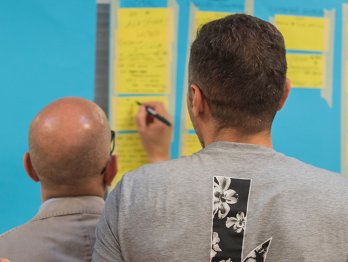Who doesn’t like scaling? But is it always desirable? And why is it so darn hard?

Who doesn’t like scaling? Innovators, governments, and international development organisations alike pursue, seek out or support innovative solutions. Common to all is the intent to scale to address societal problems, may they be big or small. Men and women across the globe innovate to better deal with everyday challenges and for many impact at scale means making a positive change in their community only, for others it might mean across the entire country or even beyond borders.
Yet, insights from the international development sector, including from the Global Community on Scaling Development Outcomes, from the International Development Research Centre, the International Development Innovation Alliance and from the OECD indicate that the notion of scale and what scaling looks like can be radically different. Not all innovations are scalable, and trying to reach ever higher numbers of people is not always the most desirable outcome. Rather, the trade-offs between magnitude and equity of outcomes need to be considered. This includes deliberations with local partners, considering that their positions might be co-operative or competitive. Scaling is political. This notion of optimal scale challenges the ‘bigger is better’ mantra, which is dominant in the private sector.
Scaling is hard, and way too many efforts to unlock the potential of innovation to address social problems do not scale, including in sectors such as health, agriculture, education and humanitarian assistance. As every innovation needs an enabling environment to scale, this is especially true for the international development co-operation sector. The innovation ecosystems in low and middle-income countries often lack essential components, including financing opportunities for different stages of the scaling journey, conducive legislation and strong social networks, to name a few. The problem that too few solutions scale does not only pertain to innovation but to investments in proven solutions. Too few development interventions unfold impact at scale in a sustained way.
To improve scaling practices for international development co-operation, the OECD is developing scaling guidance for the OECD Development Assistance Committee. A key objective is to influence how funders of Official Development Assistance work, and a secondary goal is to influence the larger development co-operation sector. The work builds on extensive existing literature and experts insights OECD Development Assistance Committee, in partnership with the Global Community of Practice on Scaling Development Outcomes and the International Development Innovation Alliance. To ground this work and enhance its usability, we invite those who work on scaling innovation or proven development practices in low and middle-income countries to input into the draft scaling guidance (see below). Our aim is to provide a useful resource to guide actions by funders, implementers and other players in the international development co-operation sector.
What is scaling?
Scaling is the process of increasing the reach and impact of a development innovation or a proven solution corresponding to a given challenge. Critically, the scale of the challenge needs to be understood. The aim of scaling is to create sustainable and widespread change within a specific geographical context and system, or to adapt a proven solution to another context. In sum, this means scaling aims to addresses a development challenge in a given context to a significant and measurable extent and on a sustained basis.
What have we learned thus far?
As we continue to develop the scaling guidance, together with our community, we have uncovered that a step change regarding scaling is needed. Experience tells us:
- Scaling can take a decade or more. Evidence from development co-operation sectors, such as agriculture and health, indicates that it takes 10 to 15 years for an innovation or a proven solution – adapted from another context – to reach impact at scale.
- Scaling does not happen spontaneously. The scaling process requires deliberate and systematic action by public and private players, supported by third-party funders, in pursuit of a vision for sustainable and optimal scale. The scaling path to reach this vision requires evidence, flexibility, a commitment to partnerships and investments in advocacy.
- Too many development interventions do not scale. The large majority of interventions – development innovation and proven interventions – fail to scale across sectors such as agriculture, education, health or humanitarian support. Development co-operation organisations, in some contexts, even hinder scaling processes, for example by providing short-term grants that are relatively easily available while insufficiently investing in helping to create conditions that can attract private investors, or by ensuring support only for a number of years and then shifting priorities, to name a few.
- No single organisation is likely to cover or fund the entire scaling pathway. Different players are required, taking on distinct roles such as doer, researcher, innovator, implementor, intermediary, funder or other functions.
- Scaling requires a dual focus: First, on the innovation or the component of a successful project that can and should be scaled. Second, on context and systems. Understanding and navigating local contexts requires continuous investments in (1) assessing structures, norms and mechanisms such as policies, relationships between actors, resource flows, power structures and values, and (2) addressing gaps and weaknesses in those areas that emerge from those assessments. Some argue that the development co-operation sector, at the moment, puts a disproportionate focus on the attributes of the solution that is to be scaled such as a digital health solution or a mobile application to provide farmers with relevant information to boost their productivity, compared to dedicated work to address systemic issues. Yet, the bigger problem is that there is too little linkage between the two domains. Scaling solutions need to pay attention to system aspects, and efforts to change systems need to pay attention to how these support or hinder the scaling of solutions.
- Scaling efforts should follow priorities of and decisions by local partners. Efforts supported by development co-operation providers to achieve positive impact at scale are more effective when local actors have decision-making power over agenda-setting and the allocation of financial resources. Scaling should adhere to good locally led development practices, understood as an ongoing development process where local actors have agency in framing, designing, delivering (including control over funding), accounting for and learning, with or without the support of international development co-operation.
- The most commonly used operational vehicle – programmes and projects – are not conducive to advance scaling as traditionally deployed. Most development innovations and proven solution interventions are operationalised and implemented in time-bound projects with clearly defined timelines that are usually not longer than five years, defined and often quite inflexible budgets, and specific outputs. In most cases, the end of a programme or project results in the discontinuation of the implementation units or the end of the support for the implementer.
- Scaling impact needs to be sustainable. Sustainability requires ensuring that local actors – doers – are in place who have the capacity, motivation and skills to continue to implement interventions at scale combined with a viable funding or business model – a payer – whether it be public, private or a public-private partnership that is aligned with fiscal constraints or constituent’s ability and willingness to pay. Too often, there is no next phase or a planned referral. Rather the prevailing assumption is that a successful programme or project will be picked up by someone and further scaled.
Contribute to the conversation: OECD Scaling Guidance (Draft)
If you are a practitioner who is working on scaling a new or proven solution or innovation in a low and middle-income context, we invite you to take a look at the OECD Development Assistance Committee’s draft guidance on scaling development outcomes and provide your feedback by 25 September 2024.
The guidance are meant to complement the principles for effective development co-operation and the principles for locally led adaptation, which have been endorsed by many members of the OECD Development Assistance Committee. The value-added of this scaling guidance lies in ensuring development co-operation efforts – be it investments in innovation or in proven solutions – integrate scaling into the selection and design of projects and programmes with a strong focus on long-term sustained impact, demand and consideration of local enabling environments.
A big thanks to all the colleagues who contributed to the development of the scaling guidance over the past 1.5 years, particularly Johannes Linn, Richard Kohl, Megan Kennedy-Chouane, Alejandro Guerrero-Ruiz, Rahul Malhotra, Mara Holzenthal, Manuela Bärtschi, Toon Driessen, Michel Seto, Jan Pettersson, Aki Enkenberg, Annika Kaipola, Erla Hjalmarsdottir, Hannah Weifenbach, Othilie Louradour Du Souich, Pascal Zimmer, Sasha Gallant, Bumi Camara, Eric Beugnot, Henny Gerner, Tharanga Godallage, Amy McDonough and Tom Feeny.












